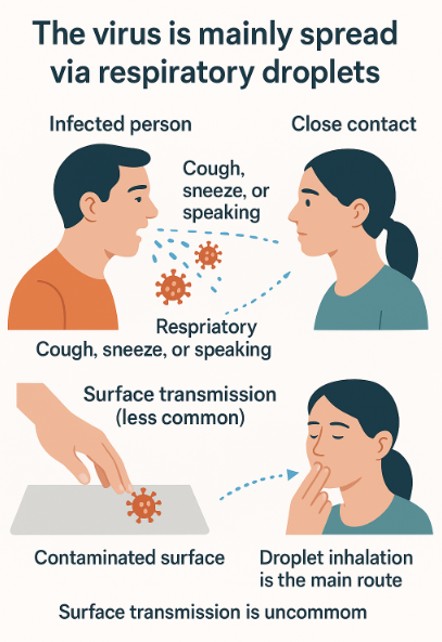Influenza
Written by: Ahmad Usman
Edited By: Adam Jones
Influenza in the Prehospital Setting Introduction
Flu is another common name for influenza, which is an infectious respiratory disease caused by influenza viruses. Organs such as throat, nose and lungs can be affected and can result in severe illness. In extreme cases, death can be caused. Vaccination every year is the best prevention for influenza, and this article will explore a comprehensive overview of influenza involving case definitions, diagnostic investigations, modes of transmission, patient management, vaccination, and infection prevention and control measures.
Case Definitions
AIt is vitally important to have clear case definitions in order to accurately track and manage influenza outbreaks. An influenza-like Illness is regarded as someone having a body temperature around 38C or above followed by a cough or sore throat. There are lab tests needed such as viral culture, rapid influenza diagnostic tests and reverse transcription-polymerase chain reaction to confirm if an individual has been tested positive for influenza. Specific viruses are identified with the conduction of these tests and it monitors the spread and intensity of various strains.
Diagnostic Investigations
It is paramount to carry out precise and timely diagnostic investigations for effective management of influenza. There are many methods available for detecting influenza viruses. Rapid Influenza Diagnostic Tests are rapid which can yield results in roughly 15-30 minutes making them useful in clinical settings for initial screening. However, this kind of testing has lower sensitivity compared to other methods which can result in false negatives. Reverse Transcription-Polymerase Chain Reaction is a more sensitive and specific test that detects genetic material of the virus. It is useful in detecting novel or emerging strains of the influenza virus and for issuing positive cases. Viral culture is another type of testing that involves the growth of a virus within a laboratory setting that can take many days but gives the most detailed information regarding the virus itself such as its susceptibility and medications.
Mode Of Transmission
This virus is particularly transmitted via respiratory droplets produced when a contagious person coughs, sneezes or speaks. These droplets can intrude on the surfaces of mouth or noses of people who are in close proximity or inhale it into the lungs. It is unlikely that a person will catch the virus by touching the contaminated surface and then their mouth, nose or eyes. For several hours the virus can remain on the surface. This helps us to understand the importance of transmission routes and how implementation is needed for effective strategies.

Management Of Patient With An Influenza-Like Illness
Management of patients with ILI aims to reduce the severity of symptoms and prevent further complications. There are antiviral medications including Tamiflu and Relenza which can alleviate the intensity and duration of disease if started within 48 hours of symptom onset. These drugs are necessary for individuals at high risk such as young, aged children, older adults, pregnant women and those having chronic medical conditions. Supportive Care would be needed. This would involve rest, hydration, over the counter pain killers such as ibuprofen and paracetamol to deal with fever and aches.
Vaccination
The most effective method in the prevention of influenza is vaccination. These vaccines operate by boosting the immune system to secrete antibodies that give protection against the flu virus. Every year the composition of the flu vaccine is updated to match with the strains spreading. Many flu vaccines are available such as inactivated influenza vaccines that are given as a shot and live attenuated influenza vaccines are administered in the form of a nasal spray.
Infection Prevention & Control
It is crucial to have infection prevention and control measures for limiting the transmission of flu specifically in schools, healthcare settings and workplaces. The key measures would involve:
Hand Hygiene
Washing hands frequently with soap and water or using alcohol based hand sanitizers.
Respiratory Hygiene
Using tissue to cover mouth and nose when coughing or sneezing.
Social Distancing
Refrain from being in close contact with infected individuals and staying at home.
Environmental Cleaning
Making a habit of cleaning and disinfecting touched surfaces and objects.
Personal Protective Equipment (PPE)
Wearing appropriate PPE by frontline workers like gloves, masks and gowns when looking after sick patients.


Key Points
- Influenza (flu) is a contagious respiratory disease that can affect the throat, nose, and lungs, sometimes leading to severe illness or death.
- The virus spreads mainly through respiratory droplets, with surface transmission being less common.
- Management includes antivirals (e.g., Tamiflu, Relenza) for high-risk groups, plus supportive care.
References
CDC. (2024). Types of Influenza Viruses. Influenza (Flu). https://www.cdc.gov/flu/about/viruses-types.html
NHS. (2022, September 5). Flu. NHS; NHS. https://www.nhs.uk/conditions/flu/
Nuwarda, R. F., Alharbi, A. A., & Kayser, V. (2021). An Overview of Influenza Viruses and Vaccines. Vaccines, 9(9), 1032. https://doi.org/10.3390/vaccines9091032
World Health Organization. (2025). Influenza (seasonal). Who.int; World Health Organization: WHO. https://www.who.int/news-room/fact-sheets/detail/influenza-(seasonal)








